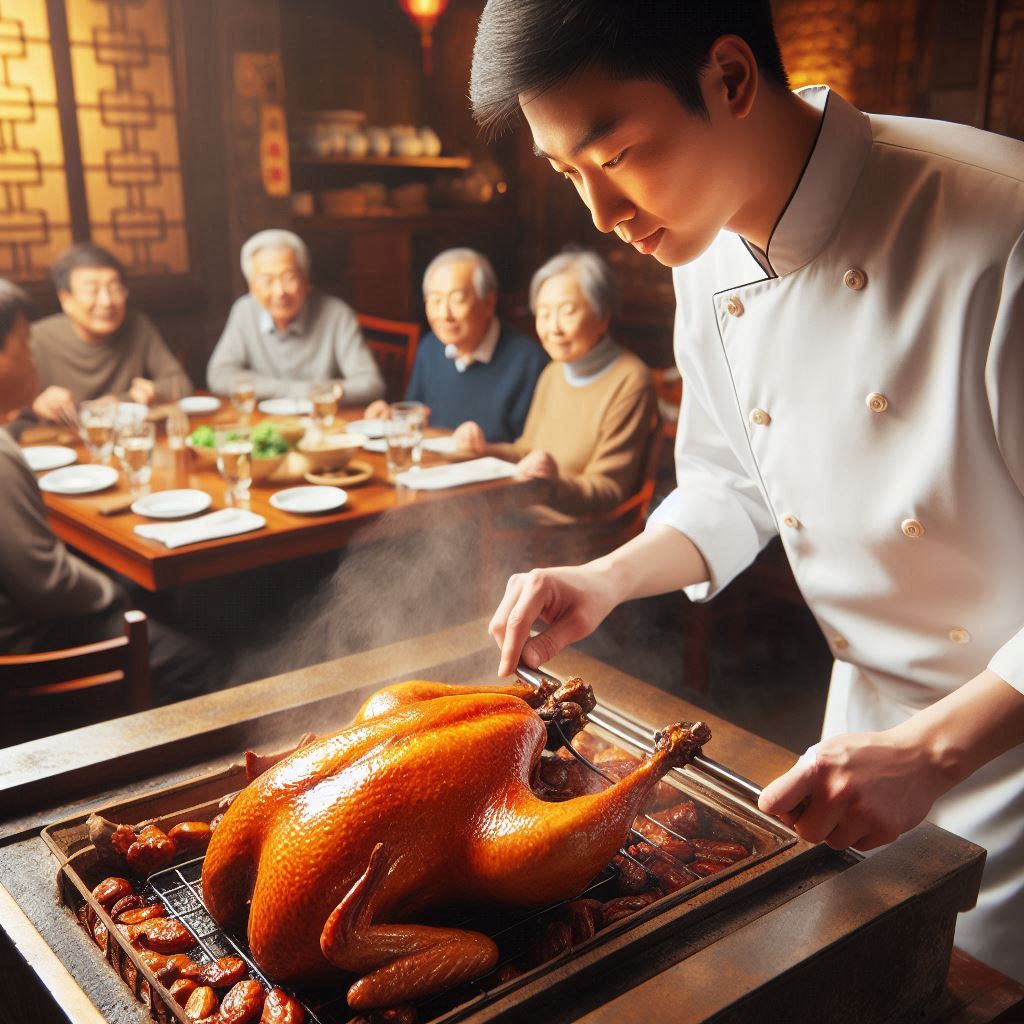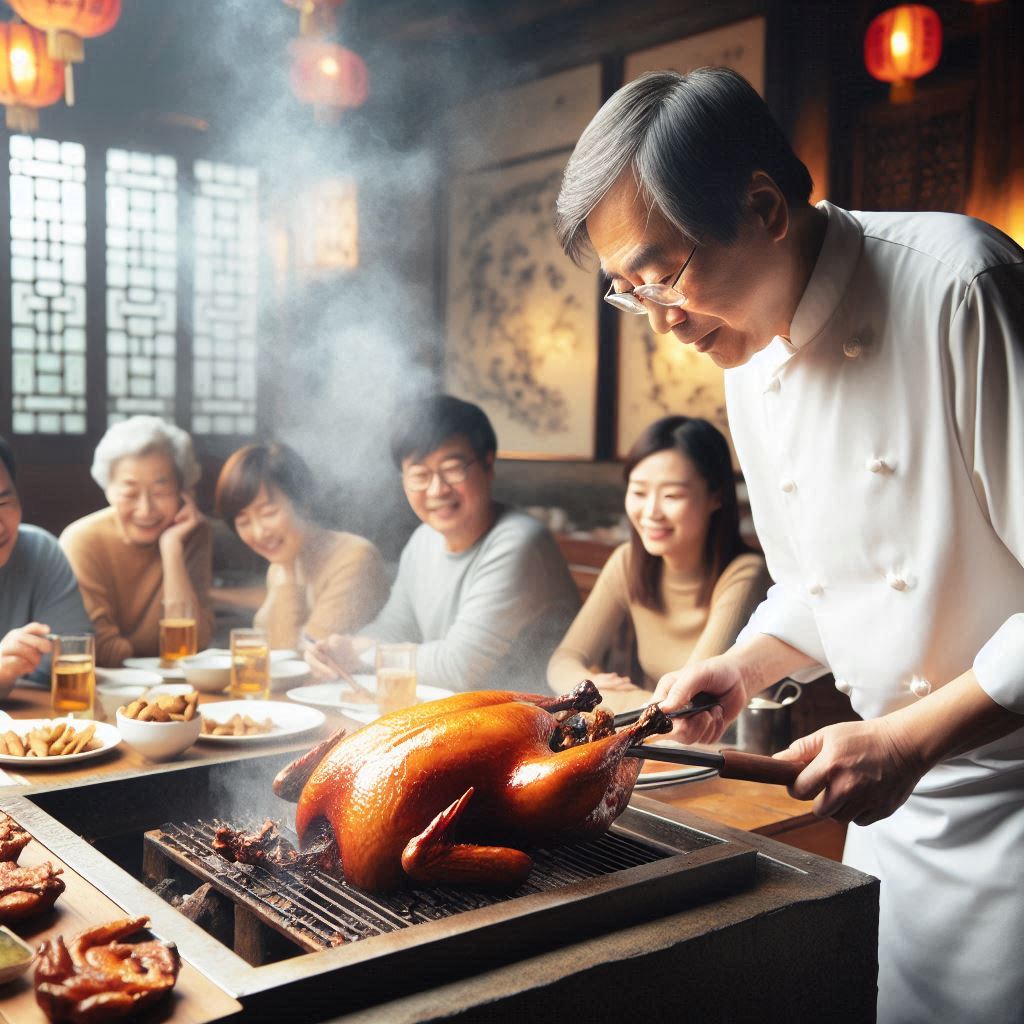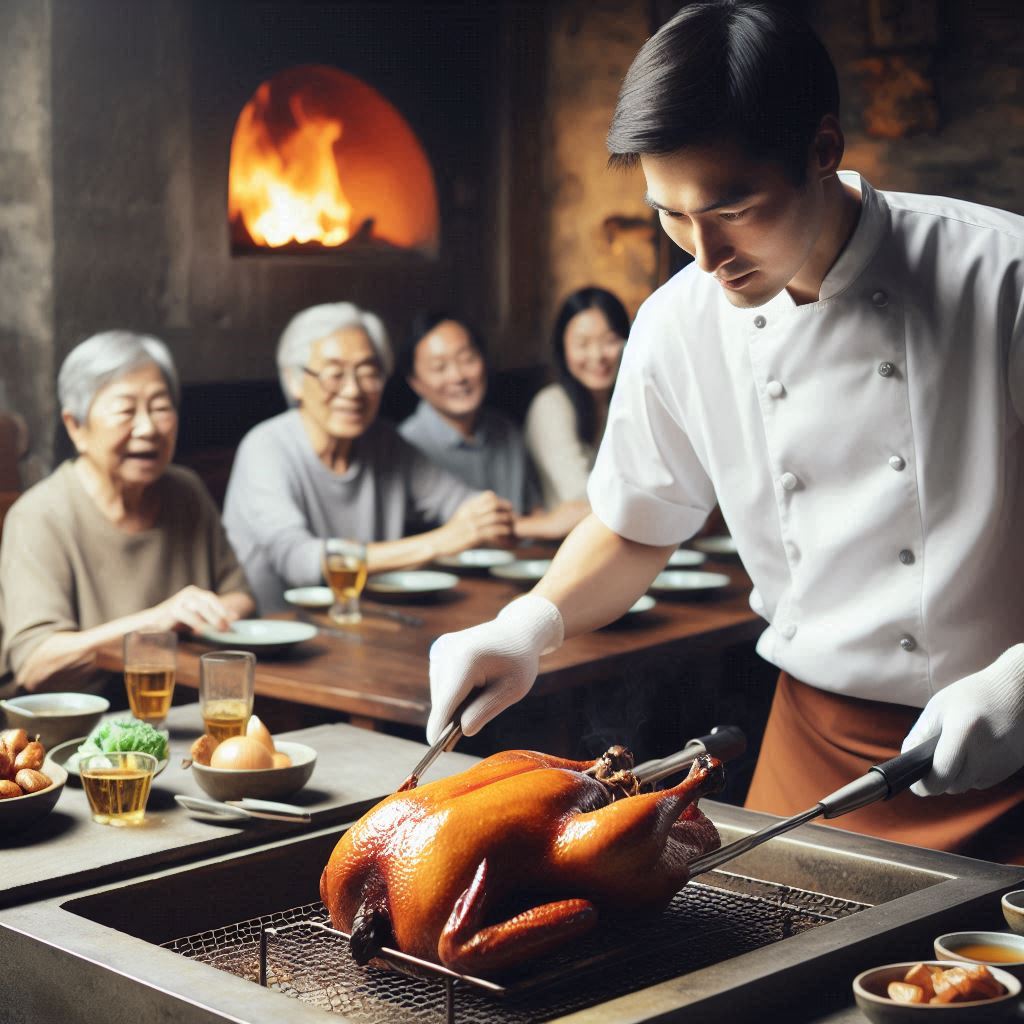北京烤鴨的做法
北京烤鴨是一道著名的中華傳統菜餚,以其脆皮嫩肉的特點和獨特的製作方法而聞名於世。起源於中國元代,但在明朝時期才逐漸發展成為皇家貢品,並在清朝成為北京的一道名菜。今天,北京烤鴨已經成為中國美食文化的一部分,吸引著來自世界各地的遊客。
製作的過程相當講究,從選材到烹飪,每一步驟都影響最終的味道和質感。首先,選用特定品種的北京鴨。這種鴨子通常在飼養期間進行特別餵養,以確保鴨肉質嫩而脂肪分布均勻。選好的鴨子在宰殺後,經過複雜的處理,包括去除內臟,清洗乾淨,並用氣體將鴨皮與鴨肉分離。這樣做的目的是使鴨皮在烤製過程中更加酥脆。
接下來是醃製和晾乾的過程。鴨子會先用特製的調料醃製,通常包括料酒、醬油、糖和一些香料。醃製的時間根據不同的食譜可能有所不同,但通常需要數小時到一晚。醃製後,鴨子會被掛起來晾乾,通常是在通風良好的地方,這個過程有助於去除多餘的水分,使鴨皮在烤製時更加酥脆。
烤製是北京烤鴨最關鍵的一步。傳統上,烤鴨使用的是專門的果木烤爐,如紅棗木或梨木,這些木材在燃燒時會釋放出獨特的香氣,為烤鴨增添風味。烤鴨時,鴨子被掛在烤爐內,並不斷轉動以確保均勻受熱。烤製的時間和溫度需要精確控制,通常在高溫下烤製45分鐘到一小時。
烤好的鴨子皮色金黃、酥脆,肉質嫩滑多汁。傳統的吃法是將鴨皮和鴨肉片成薄片,配上蔥絲、黃瓜條和甜麵醬,然後用特製的薄餅捲起來食用。這種吃法不僅能品嘗到鴨子的美味,還能體驗到多層次的口感。
製作過程中,還有一些小技巧可以提升口感。例如,在烤製前可以在鴨皮上刷上一層麥芽糖水,使烤出來的鴨皮更加光亮和酥脆。此外,烤製過程中可以在鴨肚內放入一些香料,如丁香、桂皮等,增添風味。
總之,北京烤鴨的製作是一門藝術,從選材、醃製到烤製,每個步驟都需要精心處理。這道菜不僅是北京的美食代表,更是中華烹飪文化的瑰寶,享譽國內外。無論是在高級餐館還是家庭聚會,品嚐北京烤鴨都是一種美食享受。
Peking Duck is a renowned traditional Chinese dish, famous worldwide for its crispy skin and tender meat, along with its unique preparation method. Originating in the Yuan Dynasty, it became a royal delicacy during the Ming Dynasty and later established itself as a famous dish in Beijing during the Qing Dynasty. Today, Peking Duck has become an integral part of Chinese culinary culture, attracting tourists from around the globe.
The preparation process is quite meticulous, with each step from selecting the ingredients to cooking affecting the final taste and texture. First, a specific breed of duck, known as the Peking Duck, is selected. These ducks are typically specially fed during their raising to ensure tender meat and even fat distribution. After slaughtering, the chosen ducks undergo a complex process, including the removal of internal organs, thorough cleaning, and separating the skin from the meat using air. This step ensures that the skin becomes extra crispy during roasting.
Next comes the marinating and drying process. The ducks are marinated with a special mixture, usually including cooking wine, soy sauce, sugar, and some spices. The marinating time can vary depending on different recipes, but it generally ranges from a few hours to overnight. After marinating, the ducks are hung up to dry, usually in a well-ventilated area. This process helps to remove excess moisture, ensuring the skin becomes crispy during roasting.
Roasting is the most critical step in making Peking Duck. Traditionally, the ducks are roasted in specialized fruitwood ovens, such as those using jujube wood or pear wood. These woods release unique aromas when burned, adding flavor to the duck. The ducks are hung inside the oven and continuously rotated to ensure even heating. The roasting time and temperature need precise control, typically roasting at high heat for 45 minutes to an hour.
The roasted ducks have a golden, crispy skin and tender, juicy meat. The traditional way to eat Peking Duck is to slice the skin and meat into thin pieces, served with thin scallion strips, cucumber sticks, and sweet bean sauce. These ingredients are then wrapped in specially made thin pancakes. This method of eating not only highlights the duck's delicious flavor but also offers a multi-layered taste experience.
During the preparation, some additional techniques can enhance the flavor and texture. For instance, brushing a layer of maltose syrup on the duck skin before roasting makes the skin shinier and crispier. Moreover, placing some spices like cloves and cinnamon sticks inside the duck's cavity during roasting can add extra flavor.
In conclusion, the making of Peking Duck is an art form. Each step, from selection, marinating to roasting, requires meticulous attention. This dish is not only a culinary symbol of Beijing but also a treasure of Chinese cooking culture, renowned both domestically and internationally. Whether enjoyed in high-end restaurants or at family gatherings, savoring Peking Duck is a delightful culinary experience.



照片:DALLE3
- 1
- 2
- 3
- 4
